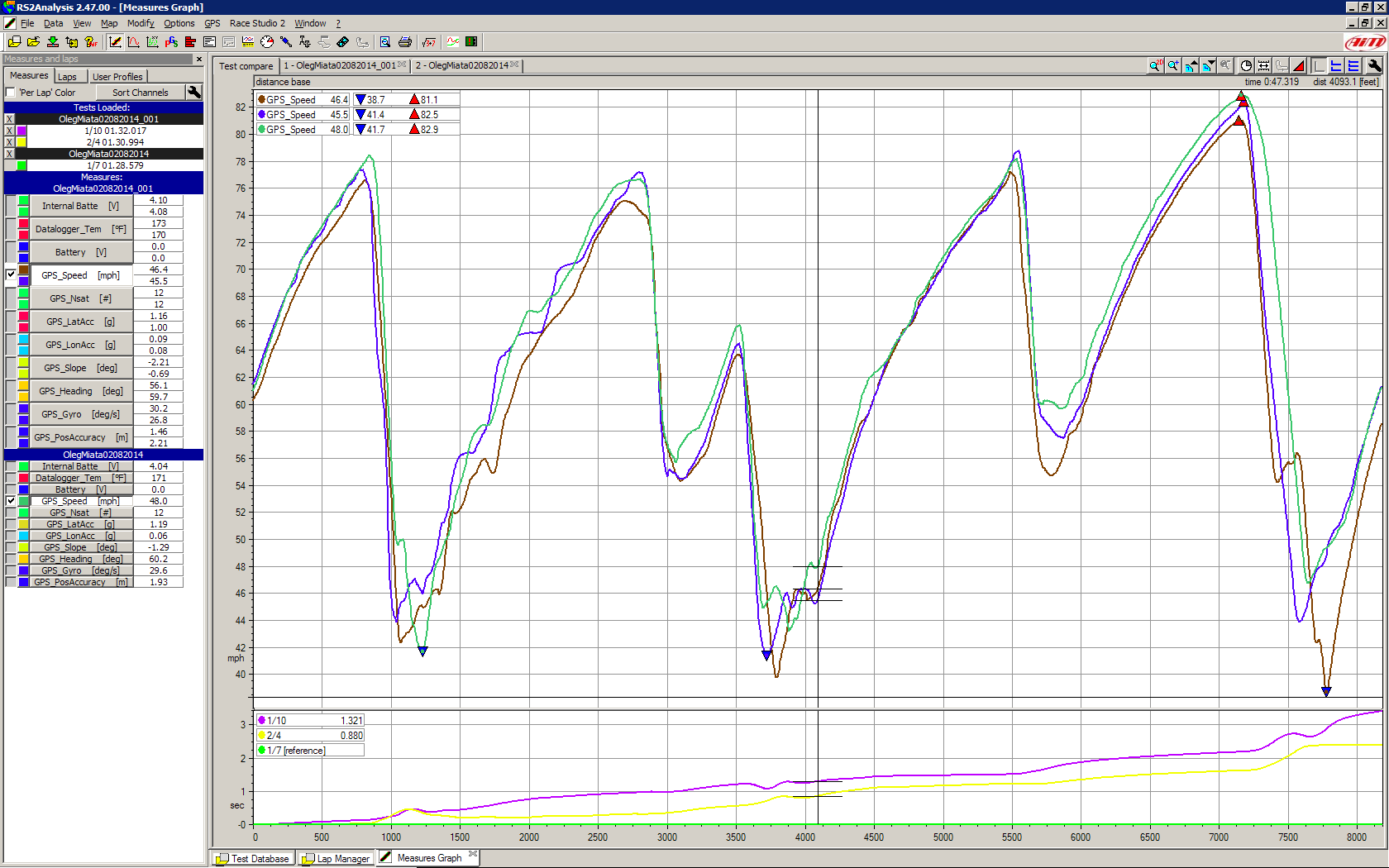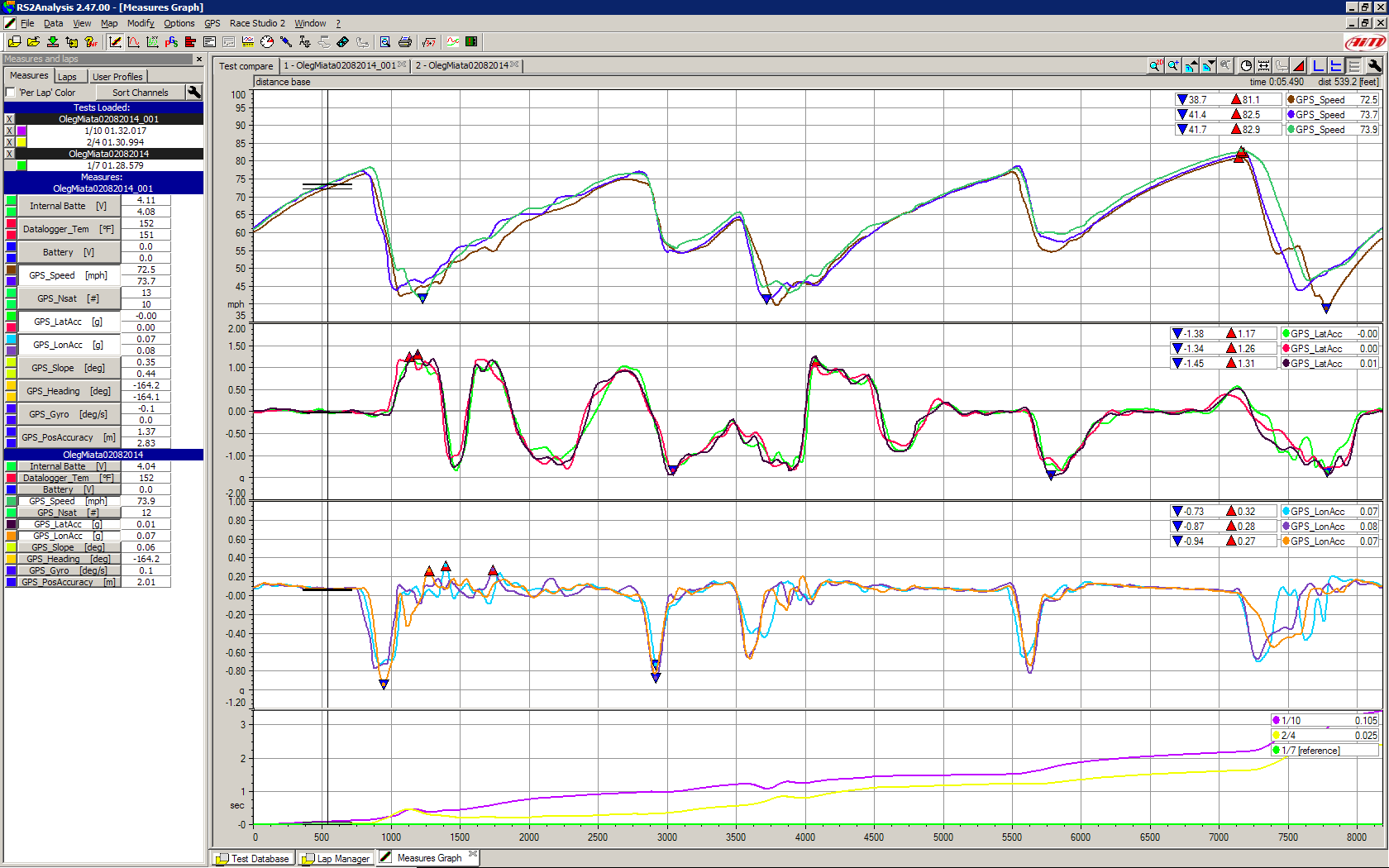Summit Point Jefferson Data Analysis
Published: August 6, 2014
I recently had an opportunity to drive the extended Jefferson circuit. It so happened that I never drove the original Jefferson circuit either, thus for me Jefferson was entirely brand new.
Instructors had three sessions total in the event, and I drove in all of them. The plan was to learn the track and at some point to drive it at a respectable pace. Unlike other events I did not have time to look at data, thus I relied entirely on predictive lap time and traction sensing for determining what was working and iterating on my approach.
Geometry/Layout
After the first two sessions I mentally identified the following important turns:
- Turn 1 which is a rather slow and long right hander, requiring patience at turn in to run a sufficiently late apex.
- Right to left transition at turn 3.
- The uphill turn, which was blind but due to massive elevation change permitted very high entry speed.
- The tightening off camber left resembling the corkscrew at Shenandoah.
- The fast left, part of the original Jefferson course.
- The final turn leading onto the main straight.
Even though there were more corners on the track, the remaining corners I took under full power and as such I did not need to think much about them.
Within these six corners, my action items thrhoughout the day were as follows:
- Turn 1's challenge was to find a reference point to turn in for the sufficiently late apex. Then, to brake later and harder - braking late and hard early was a bad idea as this corner provided no run-off to speak of.
- For the transition, I originally lifted to throttle steer the car; as the day progressed, I discovered that simply upshifting there achieved the desired effect with much less loss of time.
- I gradually increased my approach speed into the uphill turn, generally by braking later. By the end of the day there was still time left on the table in this corner, although I needed to use most of the track width at the exit.
- The off camber left was challenging the entire day as the car did not quite fit into it, and the camber change through the turn made the car lose grip at unfortunate times. The biggest improvement I made was coming into the turn slower so that at least I was on power early coming out of it.
- The fast left sweeper was wider at the exit than it was at the entrance, but it was also a long turn. Together I probably ended up driving it close to a geometrical 90 degree turn.
- The final turn was about apexing sufficiently late but also braking late as the braking zone is not really straight, and the back straight offers a high speed to be carried into the braking zone.
After the event was over I looked at the data for the three sessions. Below are speeds for the best laps of each of the sessions:
What can we learn from looking at the data?
Overbraking
The big surprise is that in the third session I have the lowest minimum speed in turn 1. I was so focused on turning in late in that turn that I managed to lose a lot of speed in it. Especially compared to the second session, the final session gives up speed and consequently time in turn 1.
Overbraking is plainly noticeable on the forward G graph:
In the third session I brake at about 1g, whereas in the first and second sessions I was braking at about 0.7g. Interestingly, the third session has no brake hold - brake pedal is going down and then it is going up immediately. The best performance would probably be achieved when there is no brake hold but brakes are applied later, to be released along the same up curve.
Improving Braking
Remaining corners for the most part demonstrate steady improvement in braking performance - I brake later, harder or both. Braking later is indicated by the speed curve dropping later, and braking harder is indicated by the curve dropping sharper.
A notable regression from second to third session is entry speed into the uphill turn - I am faster on the straight preceding the corner which means I am looking at a faster corner entry, but I lift earlier in the third session than I did in the second session due to lack of confidence.
The gain in the last corner is particularly impressive - I gain nearly a second in the approach/braking zone between the second and the third session.
Corner Entry Speed And Minimum Corner Speed
Whereas braking performance is indicated by the height of the peaks in the speed graph - higher speeds indicate later braking - cornering speeds are indicated by the depth of the valleys. Except for turn 1 as already covered and the corkscrew turn where I had trouble keeping the car pointed in the correct direction as I increased pace, minimum corner speeds have been rising throughout the day. Even though cornering speeds are objectively expected to naturally increase throughout the event, seeing the gain on graphs is nonetheless very pleasing.
I find the shape of the valleys indicative of driver performance as well.
A driver familiar with the track would generally have very smooth
valleys. A trailbraking driver would have valleys shaped like a V;
a driver who is not trailbraking but running late apexes would have
valleys shaped like a |/, and a driver who is late on power would
have valleys shaped like a U. In my case my valleys are sometimes V-shaped
and smooth, sometimes V-shaped but jagged, and sometimes U-shaped.
This indicates improvement opportunities in the respective corners.
Looking at the lateral Gs on the above graph, we can confirm that the final session achieved higher Gs which implies higher cornering speeds. The lateral G traces of the third session are also generally smoother which suggests that driving is more planned and less reactionary - another way of saying that the driver has more knowledge of the track.
Conclusions
The most important action item for my next visit to Jefferson is to eliminate overbraking in turn 1. This observation is one that I did not make while driving, and predictive lap time did not expose this deficiency either because I ran every session with the same general approach, thus there was no sudden loss of time in turn 1.
The second action item is working on confidence and finding reference points in the uphill turn. This will allow me to carry more speed through that turn.
The third action item is figuring out a line through the corkscrew that would provide enough grip to keep the car pointing in the correct direction. A track walk may be helpful here.
The fourth action item is finding reference points in the left sweeper which would improve minimum corner speed in that turn.
Finally I need to work on confidence in the last turn. There are plenty of reference points in that turn, confidence is the only problem.
Tagged: data analysis


 Visit our
Visit our